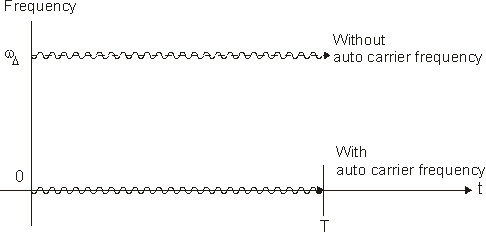FM Demodulation
For FM Frequency Modulation demodulation, Auto Carrier Frequency determines how the VSA identifies your carrier frequency. If auto carrier frequency is off, FM is the derivative of PM. If auto carrier frequency is on, FM is still the derivative of PM, but now the phase offset differentiates to 0 and auto carrier frequency removes the frequency error, wD.
Selecting performs carrier frequency estimation. The carrier frequency estimate is used to remove frequency offsets from the FM time result. If averaging is enabled, the carrier frequency estimate from the current time record is fed into an exponential average of estimates from prior time records. The resulting averaged carrier frequency is used to remove the frequency offset from the current FM time result.
The estimated carrier frequency can be shown in the Markers Window by selecting Analog Demod Carrier.
Hopping carriers are best viewed without enabled, because the estimate of carrier frequency is made as an average over each time record. See Auto Carrier Frequency with FM Demodulation for more details.
The VSA performs FM demodulation by differentiating a PM demodulated waveform. This differentiator is very accurate (± 0.005 dB deviation from ideal) over the selected frequency span.
The following illustration is an example of a carrier FM modulated by a sine wave. The illustration shows the effects with and without auto carrier frequency.

See Also
